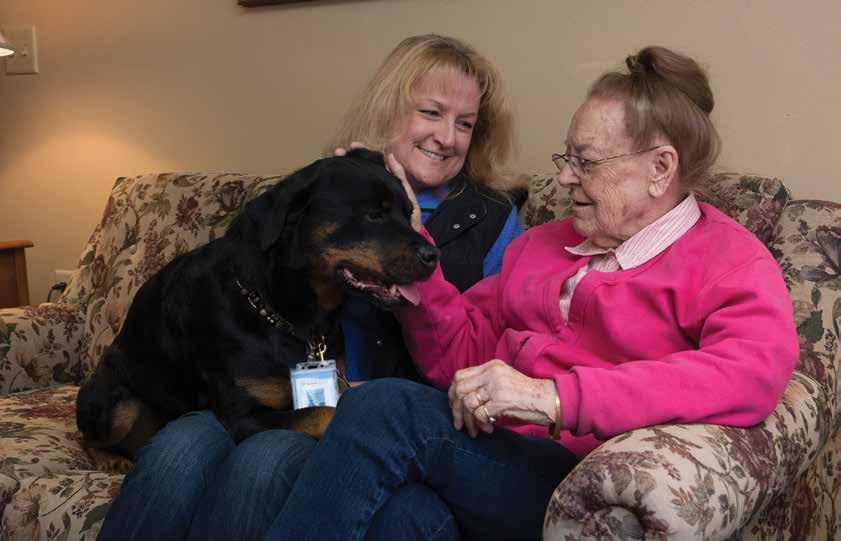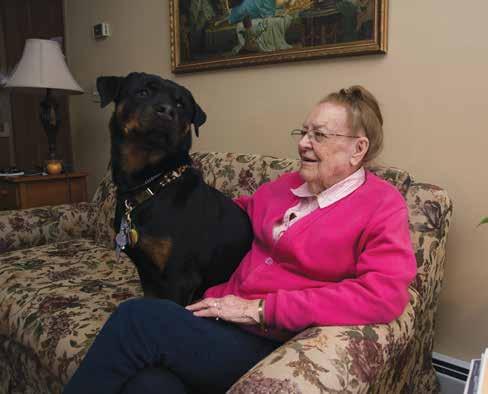
3 minute read
Pam Longville and Shine A Human/Canine Team Effort
by Esther Piszczek
OnWednesdays, Pam Longville and her female Rottweiler, Shine, wake up and prepare for work. Preparation means a full grooming for Shine, including nail trimming, teeth brushing, ear cleaning, a bath, and blow dry.
At 10:30 am, they begin in Essentia Health’s radiation oncology unit in the Miller Dwan building. After lunch, they visit the Polinsky Medical Rehabilitation Center where they work with patients in half hour blocks until 4 pm.
Six-year-old Shine is a registered animal assisted therapy dog. Pam began training her when Shine was 8 weeks old. Training involves exposure to different people and situations, familiarization with the hospital atmosphere, and learning and practic- ing commands used during therapy sessions. therapists to develop tasks the dog can do to aid in healing: petting and brushing a dog practices motor skills; throwing a ball practices arm movement, grasping techniques, and balance; speaking a command helps speech therapy patients feel accomplished when the dog responds appropriately.
“The dogs are never not being trained. We train many times a day to keep them tuned up with hand signals and commands to back up, come forward, turn around, step up, step back, get out, and get in. We train all the time,” describes Pam.
Although Shine is a larger dog, Pam worked for years with a Pekingese, a breed that weighs 7-14 pounds. Pam prefers pure bred dogs because she values knowing the dog’s temperament and medical history.
Therapy Training
Animal assisted therapy dogs are trained in four therapeutic disciplines: speech, psychology, and occupational and physical therapy. Pam works with
“Not all dogs make good therapy dogs, but any breed can be a therapy dog with the right temperament and sufficient handling and training. Common sense is more important than intelligence,” says Pam.
Pam hand picks a new puppy every two years based on personality. She looks for an independent puppy, eager to please, with “prey drive” — the instinct to chase. Each puppy begins training with a social visit to Miller-Dwan to familiarize them with the hospital smells, sounds, and elevators.
“Puppies are like children; they are like sponges. We use games and social situations to mold them to what we want. We train for perfection and the unknown,” explains Pam.
Once a month Pam takes her one and a half year old female Silken Windhound, Derby, to Miller-Dwan. Derby passed her Therapy Dogs International registra tion test in September and is just starting her career.
Therapy Dogs Inter national (TDI) is a nonprofit, volunteer run organization that regu lates, tests, and registers therapy dogs and their handlers for service in hospitals, nursing homes, schools, and other institutions. Pam has been a TDI instructor and evaluator for 21 years.
Born in Brainerd, Pam began training dogs and horses as a child. Thirty-five years ago she took a puppy to an obedience class at Twin Ports Dog Training Club.

“I ended up loving the formal part of obedience. I just continued training and got asked to train as an instructor,” explains Pam, who has been the club’s Director of Training for over 20 years.
Pam says she enjoys the problem solving aspect of dog training, whether it involves helping handlers elicit specific responses from their dogs, working through behavior problems, helping a fellow obedience competitor, or teaching a dog a task to help patients therapeutically.
Volunteer Service Rewarded
Pam began volunteering at Miller-Dwan in 1993 when she and two other dog handlers were asked to develop an eight-week animal assisted trust them explicitly and they trust me. When we lose one of these dogs, it’s not just me grieving, but all the patients that have worked with them,” says Pam, who will celebrate 23 years in the program in
Fellow handler Ramona Larson, with her Irish Setter and Irish Red and White Setter, also works at Miller-Dwan on Wednesdays. In 2012, Essentia Health awarded Pam and Ramona the Ernie Pearson Lifetime Achievement Award for their volunteer therapy work. The award is given to those who assist persons with disabilities.
Pam adds, “We work as a team. Miller-Dwan and St. Mary’s have been more than good to us. They treat us like family. We’ve been blessed with great therapists and the opportunity to help patients recover. It’s been a good thing.” D to help the patient, but also there to pro tect our dogs who are innocent. They are working because they are being asked to work. There is a relationship there that is hard to explain how deep it goes. I

To learn more about Miller-Dwan’s animal assisted therapy program, visit www.mdfoundation.org/special-projects/ animal-assisted-therapy.








